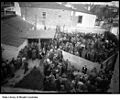Norfolk Hotel, Fremantle facts for kids
The Norfolk Hotel is a historic building in Fremantle, Western Australia. It stands on the corner of South Terrace and Norfolk Street. This hotel was built from stone in 1887. This was before the big gold rush started in 1893.
The hotel was built for George Alfred Davies. He was a person who sold wine and spirits. He was also a local leader and even the Mayor of Fremantle. For most of its history, the hotel was known as the Oddfellows Hotel. It got its new name, Norfolk Hotel, after a major renovation in 1985.
Contents
History of the Oddfellows Hotel
The Oddfellows Hotel was finished by 1887. It was built for George Alfred Davies, who was famous for selling wine and spirits. George Davies was born in Fremantle in 1846. His family had moved to Western Australia only five years after Captain Fremantle claimed the area for Britain.
George first worked with his father, Albert. Later, he started his own business called Grosvenor Cellars. He sold alcoholic drinks and even made his own wine. George Davies was also very active in public life. He served as a local councillor and became the Mayor of Fremantle in 1895.
The land where the hotel stands today was once rented out by Davies for small houses in 1880. He officially bought the land in 1884. By 1887, the stone hotel was built and recorded. The hotel was a successful business. It continued to do well even after George Davies passed away in 1897. His wife, Letty Davies, and his brothers, George Davies and Arthur Elvin Davies, managed the hotel through a special arrangement called a trust.
Around 1920, the inside of the building was changed. The hotel started focusing more on selling drinks and offering a place to relax, rather than just providing rooms for people to stay overnight. A few years later, in 1922, the Castlemaine Brewery bought the building from the family. Within five years, the Oddfellows Hotel was run by the Swan Brewery. This happened because Swan Brewery and Castlemaine Brewery joined together.
The Swan Brewery managed the hotel for over 50 years. A photo from the 1950s shows the building with tram lines nearby. The brewery sold the hotel in 1952 to private owners. Another picture from 1953 shows the beer garden full of people celebrating on Derby Day.
The Norfolk Hotel Today
The Oddfellows Hotel had big changes in 1985. This was just two years before the 1987 America's Cup sailing competition was held nearby. About $500,000 was spent on renovating the building. A large part of the hotel was taken down to create a small outdoor area. The building still has two floors and a metal roof. It also has a basement with an entrance from Norfolk Street. An interesting old feature that was kept are the wooden doors on the first floor. These doors were used to lift heavy items into the building.
The hotel was sold for about one million Australian dollars to a company called Brewtech Pty Ltd. This company also owned the nearby Sail and Anchor Hotel. In 1987, Brewtech changed its name to the Matilda Bay Brewing Company. Then, in 1990, a larger company called the Foster's Group bought Matilda Bay. In 1989, Garry Gosatti bought the right to run the hotel. He was one of the original partners of the Matilda Bay Brewing Company.
In 1992, the Prendiville Group bought the building. This group owns many other properties, including Sandalford Winery and other hotels.
In 2001, Garry Gosatti renovated the hotel's basement. He turned it into a place for live music. Since early 2002, it has been used as a music venue called "The Basement." It is now known as "Odd Fellows Bar."
During the 2013 Fremantle Street Arts Festival, the Norfolk Hotel was decorated with a special wall sculpture. It showed the first female Australian senator, Dame Dorothy Tangney. The artwork was carved by a Portuguese artist known as Vhils (whose real name is Alexander Farko) and his helpers. Vhils is famous for creating his sculptures by digging into surfaces.
Why the Hotel is Important
The Norfolk Hotel is listed on the City of Fremantle's local heritage list. It was added in September 2000. It is important because of its connection to George Davies. Also, it is an unusual stone building that was built before the 1893 Kalgoorlie Gold Rush.
Images for kids




